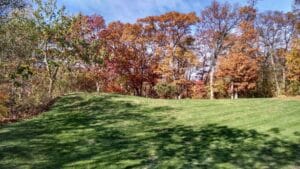Fall leaf cleanup is an essential part of maintaining a healthy lawn and garden. When the leaves begin to fall, it’s important to address them in a timely manner to prevent lawn damage and ensure the aesthetics of your yard. Here are some tips for effective fall cleanup:
# 1 Rake Regularly, Not Just Once
While it may seem like a once-and-done task, leaves tend to accumulate throughout the fall. Regularly raking or using a leaf blower helps to keep leaves from piling up too much, which can suffocate your lawn and encourage mold growth.

# 2 Use a Leaf Blower for Efficiency
If you have a large yard, a leaf blower can save you time and effort. It can also be used in conjunction with a rake to move leaves into piles. Blowers also help to clear leaves from difficult-to-reach areas like garden beds or around shrubs

# 3 Compost the Leaves
A major factor people face is disposing of the leaves. Instead consider composting them in a pile. They make excellent compost material, especially when combined with other organic matter like grass clippings. Shredding leaves first speeds up the decomposition process.

#4. Aerate the Lawn After Leaf Removal
Once the leaves are cleared, consider aerating your lawn. Aeration allows air, water, and nutrients to reach the roots more effectively. It’s also a great follow-up step after a fall cleanup to promote lawn health for the spring.

# 5 Don’t Forget Garden Beds and Borders
Leaves can accumulate in flower beds, around shrubs, and along garden borders. While some gardeners may want to leave a blanket of leaves to protect plants from the cold, too much can create a wet, decaying mess. In contrast, consider removing excess leaves from these areas or mulching them.

# 6 Keep Leaves Out of Drains
Undoubtedly, clogged gutters and drains are a common issue during fall. Make sure to clear leaves from your gutters and downspouts to avoid water damage to your home. A leaf blower or small rake can help remove leaves from the drainage system.


